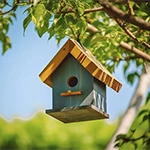Shrubs, trees and lawns near the house contribute to improving thermal comfort in the home
Trees and shrubs near the house provide natural shading, which can reduce direct exposure to sunlight and cool the area. The dense foliage of trees and shrubs can block some of the solar radiation and reduce excessive heating of the walls and windows of the house.
The heat island effect refers to rising temperatures in densely populated urban areas as a result of asphalt and concrete surfaces absorbing and retaining heat. Lawns and vegetation around the house help to reduce this effect, as the soil and vegetation absorb less heat than asphalt surfaces, contributing to a lower temperature around the house. Plants, including turf, have the ability to absorb water through their roots and release it into the air through transpiration. This plant transpiration process can help cool the air around them, creating a cool feeling around the house.

Vegetation near the house, such as trees and shrubs, plays an important role in filtering pollutants from the air and improving its quality. This is a great added value during the heat wave, when air pollution can be more pronounced and affect air quality. A healthy lawn and well-maintained vegetation can help conserve water by holding moisture in the soil. This can be particularly beneficial during times of drought or heatwave when water resources are limited.
To get the most out of these advantages, it is important to take care of the plants near the house. Make sure trees and shrubs are well maintained, watered properly and trimmed regularly. As for the lawn, make sure it gets enough water and is mowed regularly.
Plant a tree near your house today and you will be happier tomorrow
Trees can act as a natural barrier against traffic noise or other sources of noise pollution, thus providing a quieter and more pleasant atmosphere around the house. They provide shade during the summer, thus reducing excessive heating of the house and the surrounding land, and can improve the thermal insulation of the house in the cold season. Planting a tree can attract various species of birds, insects and other animals, thus contributing to the biodiversity of the area and creating a more balanced ecosystem.
Getting a child involved in planting a tree can have long-term benefits for both them and the environment. This educational and emotional experience can help develop an ecological awareness and responsibility towards the environment, thus encouraging a more positive attitude and involvement in nature conservation.
Planting a tree provides a great opportunity to teach your child about natural cycles, plant growth processes and the importance of ecology in general. During this exercise, the child can understand how ecosystems work and the importance of conserving natural resources.
By getting involved in planting and caring for a tree, the child will learn responsibility and the importance of caring for the environment. Long-term tree care, such as watering and cleaning, will teach it to engage with and care for nature.
Planting a tree can give a child a special emotional connection with nature and the environment. While the tree grows, the child will have the opportunity to observe the changes and enjoy its progress, thus creating a special connection with nature.
Getting involved in a tree planting project can help build a child’s confidence and skills. Participating in a concrete project and seeing the tree grow because of his efforts can give him a sense of fulfillment and satisfaction.
Planting a tree can be a symbolic act of the lasting legacy we leave to future generations. The child will have the chance to see the positive impact it has on the environment and can continue the tradition of planting trees and taking care of nature in the future.
It is recommended to consult a forestry specialist or a landscaper for proper advice on planting trees near the house. It’s important to make sure you don’t plant trees with aggressive roots too close to your home’s foundation, underground pipes or power lines to avoid potential problems in the future.
















